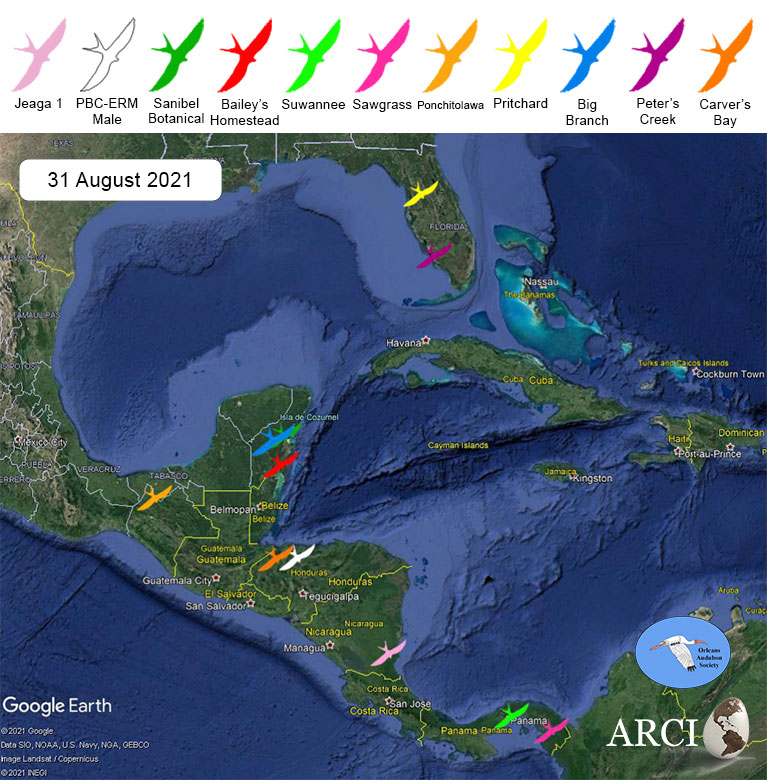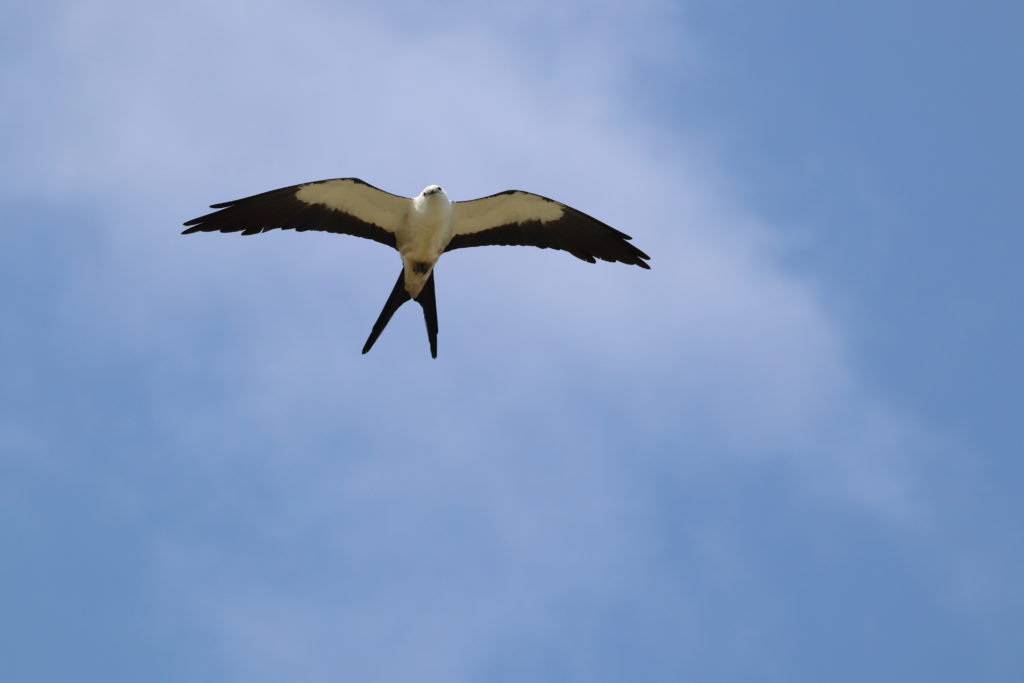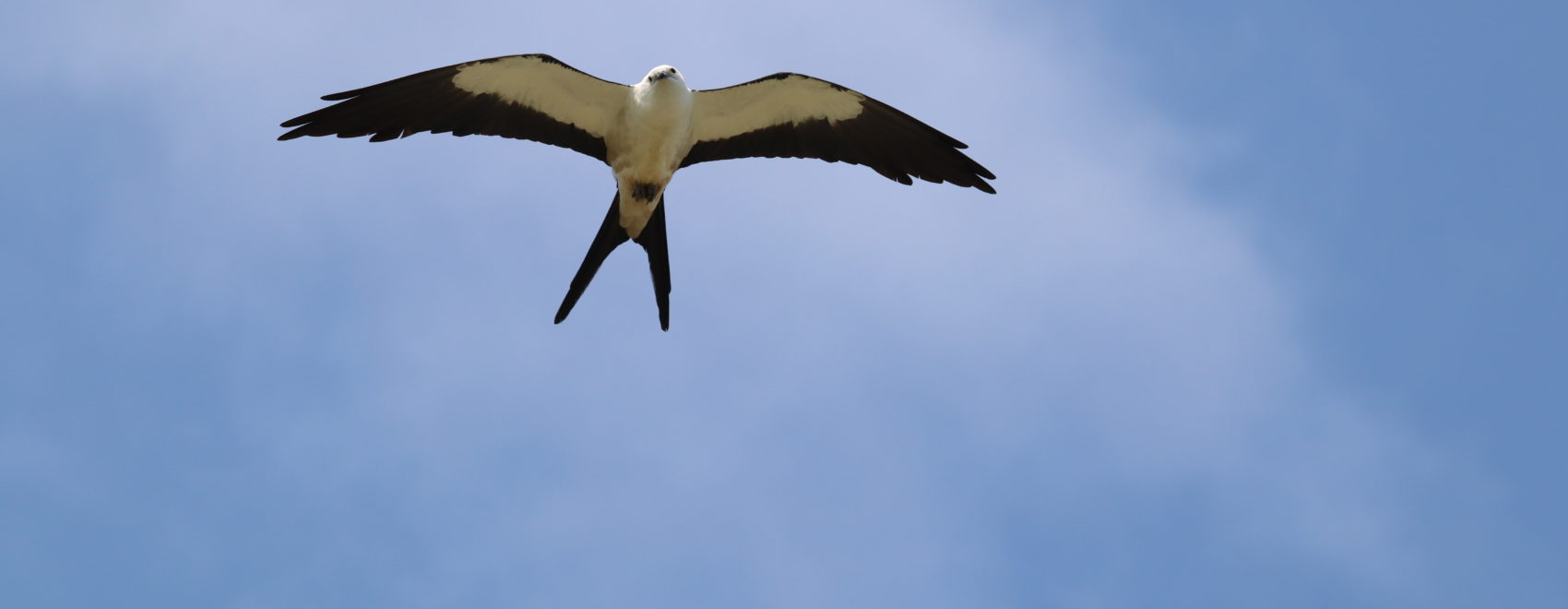Our previous Swallow-tailed Kite migration update left us with two birds over the Gulf of Mexico. YES, they did make it and are now safe and sound on the Yucatán Peninsula! These two female kites, tracked by GPS, are both from South Carolina. Carver’s Bay left Florida on 13 August, crossed the Gulf all the way to southern Belize, and last checked in from Honduras on 16 August. Big Branch left Florida on 17 August and is making a stopover in Mexico before continuing south.

Generally, the timing and tracks across the Gulf for many of our GPS-tracked Swallow-tailed Kites are shaped by the prevailing winds of hurricanes and tropical storms that are active in the Caribbean and Gulf of Mexico at the time. These birds apparently can sense related changes in the atmosphere and respond by using favorable tailwinds to cross the open water as fast as possible. Despite all the tropical storm activity in the last few weeks, we have witnessed “textbook” migration tracks by our tagged Swallow-tailed Kites that have carried them across the Yucatan Channel and western Caribbean.
Sawgrass, a female from Pinellas County, Florida, is now in Panama leading the pack of 11 GPS-tracked birds. She also stopped in Quintana Roo, Mexico for five days of refueling before continuing south.

Suwannee is following Sawgrass’ path through Panama, only two days behind. Jeaga #1 is pressing on through Nicaragua and is 400 miles behind the two kites in Panama.
PBC-ERM Male’s most recent location was in Honduras on 20 August, near Carver’s Bay’s location. We were pleasantly surprised to receive a long-awaited data upload from him once he reached the Yucatán.
Ponchitolawa, tagged by Dr. Jennifer Coulson and Orleans Audubon, has taken the alternative, circum-Gulf route (i.e., over land) that he has used repeatedly since we first started following him in 2019. He left well ahead of Hurricane Ida, starting westward on 19 August before turning southward through Texas and Mexico. Currently, he is in the state of Tabasco, Mexico. Kites from the western part of their U. S. range often take this over-land route, which avoids the risks of an open-water crossing.
We have no new data to report from the GPS-tracked birds tagged on Sanibel Island, Florida. We know they made it safely to the Yucatán, so we are assuming that they are beyond cell reception and, thus, are unable to upload their more recent location data.
We will continue to watch these Swallow-tailed Kites push southward to their South American wintering range. Two of these birds are about to cross the Gulf of Mexico. Additionally, we are thinking of all the people, flora, and fauna across the Caribbean and Gulf that have suffered from the recent severe tropical weather, including our dear colleagues and friends Jennifer and Tom Coulson in southern Louisiana.
This work would not be possible without our dedicated supporters and collaborators. For our current 11 GPS-tracked Swallow-tailed Kites we thank:
American Bird Conservancy (ABC)
bioGraphic
CROW – Clinic for the Rehabilitation of Wildlife, Inc.
Florida Panther National Wildlife Refuge
Forest Investment Associates (FIA)
Friends of Florida Panther National Wildlife Refuge
Friends of Palmetto Bluff Conservancy
Friends of the Lower Suwannee & Cedar Keys National Wildlife Refuges
International Paper (IP)
Lower Suwannee National Wildlife Refuge
National Audubon Society
Orleans Audubon Society
Palm Beach County Department of Environmental Resources Management
Palm Beach Zoo and Conservation Society
Palmetto Bluff Conservancy
Resource Management Service (RMS)
Sanibel-Captiva Audubon Society
Sanibel-Captiva Conservation Foundation SCCF
St. Augustine Alligator Farm Zoological Park
St. Petersburg Audubon Society
The Avian Reconditioning Center for Birds of Prey
White Oak Forest Management


Exciting update. Thank you!